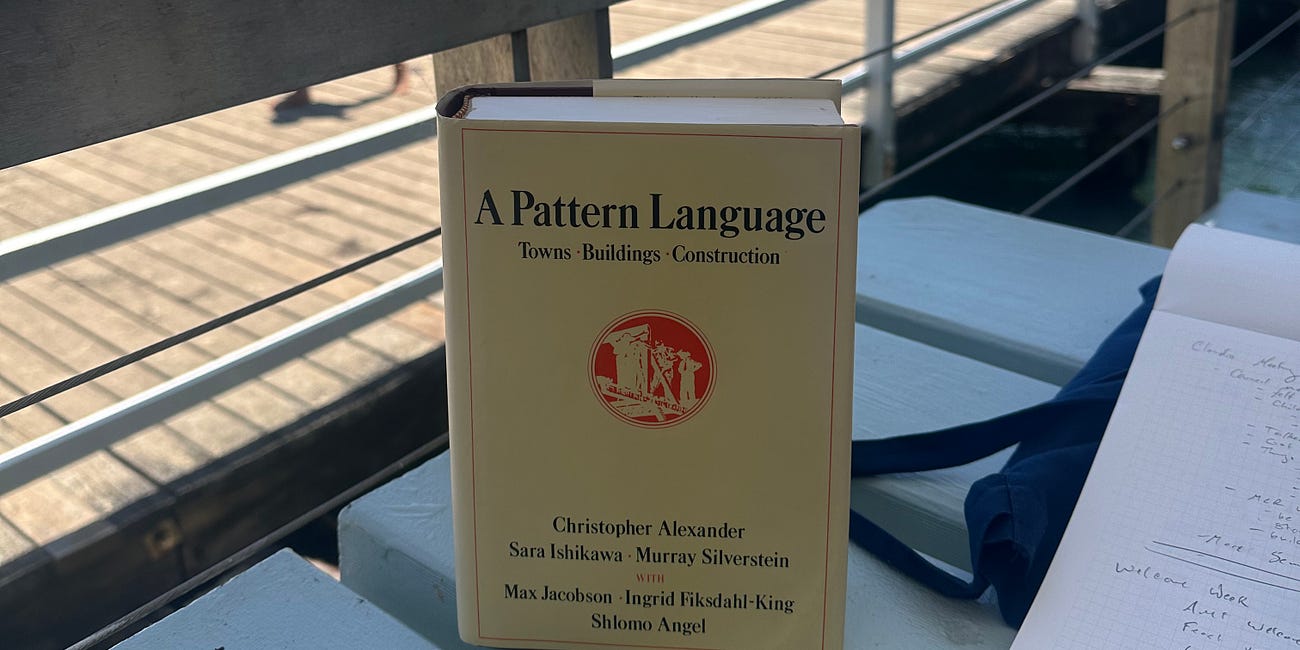Pattern of the Week 7: Neighbourhood Boundary [7]
Edges, in cities and in identities, are good. Build them.
If you are new to Pattern of the Week, an explanation is here:
Tools for the Journey: The Book about Everything/Pattern of the Week 1
Gather ‘round the green everyone – here’s issue 2.
Today, I turn my attention to pattern 15: Neighbourhood Boundary - or rather, I have had my attention turned to it, largely by reading some exerpts from Kevin Lynch’s The Image of the City, an early an influential text on urban planning. It differs from modern urban planning texts in that it is written in clear, meaningful, and readable prose, and is about planning a successful city, rather than navel gazing about the meaning and discourses of the act of urban planning itself.
Read old books, kids - they tend to be pretty good.
Anyway, one of Lynch’s great insights was the realisation that the psychological and emotional perception of a city matters a lot more to how people use the city than actual realities like distance or slope. A walk feels short, eg, if it is interesting and pleasant, while a short walk over an unshaded, straight, unyieldingly samey Modernist boulevard can feel almost eternal.
Lynch establishes five features that define the feel - or the Image, if you take his title - of a city in the mind of its inhabitants: paths, edges, districts, nodes, and landmarks. With the exception of nodes, these are all common words that the reader can confidently understand to mean what he or she thinks they mean, so I won’t go into them deeply. I will only mention that “nodes” in this category are basically meaningful social intersections - more like a popular newsagent, or a train station that is also where public demonstrations take place, rather than just the transit intersection of the train station itself. They are distinct from landmarks because Lynch reserves “landmark” for great big things that you do not actually enter, but use for navigation: a mountain on the horizon that tells you where North is is a landmark, while a Cathedral that you go into for worship each week is more of a node. (If you don’t worship at that cathedral, but everyone in the neighbourhood uses it for navigation, then it is a landmark.)
As I read this, I found myself in broad agreement with Lynch, but thinking, as usual, of Alexander’s patterns. And of the clarity they provide. It seemed to me that edges - the impermeable or semipermeable boundaries in a neighbourhood - a river, a highway, a wall, a green strip - are far and away the most important concept in how we conceive of where we live and how we live in it.
Alexander writes that “the strength of the boundary is essential to a neighbourhood[‘s]… identifiable character.
Hemce, in Sydney, Balmain is a place:
And Marrickville is a concept, sort of, with overlap into Enmore and Newtown, more of a vibe than a place. It has only one good edge, that means it isn’t Earlwood or Undercliffe:
Lynch’s paths and districts, and to a lesser extend nodes, can be subsumed to edges, and it is edges that give us our sense of self, of place, and of community. I won’t go too deep into it, but it should be obvious that the conceptual, rather than physical, edge, is also terribly important to our self-concept - who are we, who do we trust, who do we collaborate with, &c. &c.
At the end of a long century of “opening”, we have been taught that these kinds of edges are bad. I disagree. What is bad is the hatred of the other side of the edge. The edge, properly conceived, helps us to know who we are and who they are, and indeed, to appreciate who they are. Different cultures are good - they are interesting, contain wisdom and innovation and luminous ideas. A world without edges, where that difference dissolves into amalgamation, has fewer niches for beautiful ideas. (A Point I also made in last week’s video Village Green. Love the other side of the edge, but keep it. Build it. Know who you are.
Especially in your neighbourhood. No one wants to live in the middle of an infinite grid to the horizon. Or as Alexander says: “Form [a] boundary by closing down streets and limiting access to the neighbourhood - cut the normal number of streets at least in half. Place gateways at those points where the restricted access paths cross the boundary, and make the boundary zone wide enough to contain meeting places for the common functions shared by several neighbourhoods.” (Emphasis added).
Boundaries, but with meeting places for collaboration. Real diversity. Edges.






